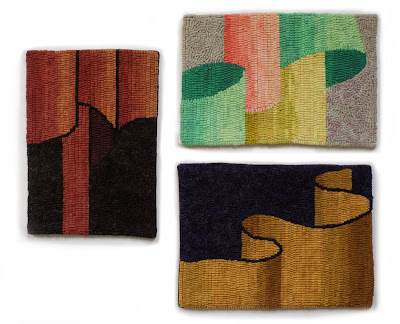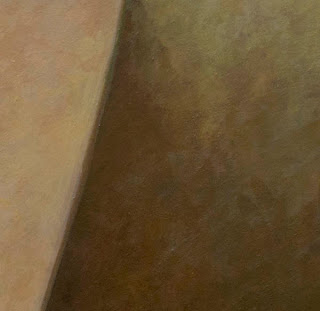A Baker's Shop, 1888; oil on canvas, 44 1/2 x 35 1/2 in.
A woman, dressed in black, the ample shape of her back turned toward us with only a glimpse of graceful neck; three rows of shelves on a white tiled wall; the only color a subdued warm ocher of counter tops. The close harmony of grays and blacks, the stillness, the soft light, the simple compositions lend to Hammershøi's paintings a sense that we are seeing what is essential in his world and thus in ours. I was introduced to the work of the Danish artist
Vilhelm Hammershøi (1864-1916) on a trip to Scandinavia thirty years ago. I fell in love with the paintings then, along with those of the Danish Golden Age painters (I wrote a blog post on the figurative work
here, and the landscapes
here.) I photographed the images for this post from a 1981 catalog of a retrospective held that year in Copenhagen. During his lifetime Hammershøi's work was admired in Europe, but often ignored in his native Denmark. In recent years there has been revived interest in Danish painting, even here in the US.
Portrait of a Young Woman, the artist's sister, Anna, 1885; oil on canvas, 44 1/4 x 36 in.
In this early painting of his sister, Hammershøi had already found his form and his content. The simple mass of black with the surrounding muted colors of wall and door allow us to focus on the quietly introspective face and gently placed hands. There is a feeling of expectation in her slight lean forward, but it is a self-contained energy.
Young Woman Sewing, 1887; oil on canvas, 14 1/2 x 13 3/4 in.
A second portrait of Anna is even more stripped down. I love the way the triangular white shape of the cloth repeats the larger shape of the figure. There is a poetic grace in the gesture of the figure, the downward looking head, the raised arms, set in front of a gray wall.
Portrait of Ida Ilsted, later the artist's wife, 1890; oil on canvas, 42 x 34 in.
Many of his portraits have a feeling of deep melancholy, even this of his bride to be in her dark clothing, with curled fingers on her lap. Her gaze is direct, but also wistful.
Resting, 1905; oil on canvas, 19 1/2 x 18 1/4 in.
I have thought of Hammershøi as a "poet of the back" for his many paintings of figures turned away from the viewer. It is surprising how eloquent a woman's back can be, as in the baker's shop painting above, and here in
Resting. The slope of the woman's shoulders adds a flow of energy, and the soft back and arm pressed against the rigid geometry of the chair speak of vulnerability. But there is also the feeling that a person turned away is denying us their attention and presence, and that they are maintaining their core of mystery.
Interior with a woman seated on a white chair, 1900; oil on canvas, 22 1/2 x 19 in.
Here we look through the geometry of interior spaces, very much like those of Dutch 17th century painters, but the figure animating the space is again keeping her distance.
Interior with a Punch Bowl, 1907; oil on canvas, 25 x 23 in.
Hammershøi painted many interiors, mainly of his own house. To the clear geometry he adds interesting kinds of balance, as here with a large empty wall anchored by a table with a bowl on it; the blue of the bowl converses with the desaturated blue of the wall in the distant room. The light is a soft northern light, gently illuminating the interior.
Dust motes dancing in sunlight, 1900; oil on canvas, 27 1/2 x 23 1/4 in.
Very few of Hammershøi's paintings have direct sunlight, so this painting of dust motes pleases me very much; what a delightful idea. But even in the light the room is empty and quiet and solemn.
A Farm, Refsnæs, 1900; oil on canvas, 21 x 24 1/4 in.
I am most interested in Hammershøi's figures and interiors, and have concentrated on those, but he also painted landscape and architecture, so I end with this painting of farm buildings, starkly outlined against a sunlight that is leached of color, and pressed by the weight of the sky. It is interesting to think of him working at the same time as the impressionists and post-impressionists with their vivid light and color. He is a far-northern painter, with a northerner's sensibility, a subtle poet of minimal light and of quiet.



















































